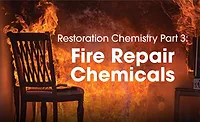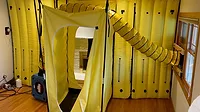Fire and Furry: Effectively Using Containment to Create Cleaner Indoor Air

Photo credit: deyangeorgiev/ iStock / Getty Images Plus via Getty Images
No, that is not a typo, it is definitely meant to be furry and not fury. We are talking about indoor air quality (IAQ) here, not Armageddon. But make no mistake about it, for severe allergy sufferers the differences often feel like semantics. The pet dander from our “furry babies” can render some nearly incapacitated. Whereas the spores and fragments from that furry patch of growing mold on your wall can also cause health problems. Also the smoke and its residue, either from a wildfire outdoors or a structure fire indoors, those contaminants too can pose significant health threats.
Real Dangers from Pollen, Allergens, Mold and Smoke
Allergies are not just an inconvenience and should not be minimized or dismissed as crazy talk. They can have a serious impact on a person's ability to function, whether the offending materials are produced from animals or plants. Giving up pets and maintaining a scrupulous cleaning regimen indoors can control many allergens despite fluctuations in seasonal pollen levels that often leave a significant residue that coats surfaces, including cars and clothing. Oddly enough, when viewed under a microscope most pollen grains look furry. Ultimately, the outdoor pollen migrates indoors. This is why many seasonal allergy sufferers stay in air-conditioned spaces with HVAC systems equipped with extra filtration. Pollen count can really only be mitigated on a large scale by the end of allergy season or by a really good rainstorm.
However, rainstorms can be a double-edged sword for controlling furry contaminants. Any flooding or water intrusion can quickly lead to mold growth. But in an ironic twist, too dry can also cause the furry contaminants to be replaced by fire contaminants. Severe firestorms seem to be the new normal, caused in the western United States by two decades of low precipitation, slash and burn deforestation in South America, and desertification in Australia and Africa. The smoke and fire residue from such conflagrations can be absolutely debilitating, deadly even, especially to those with COPD, asthma, heart disease, emphysema, etc.
Traditional Methods for Managing the Threat from Air Contaminants
In the most significant cases, healthcare providers have to relocate high-risk patients until the threat of poor air quality caused by excessive smoke can clear. This is expensive, disruptive and is often nothing like a vacation for the individuals who have to be displaced from their homes, hospitals, nursing homes and other specialty care centers. The situation is compounded by the fact that many of the people that are subjected to this treatment are often frail with other significant health concerns. Moving them away from their care team and their friends and family support network can be very disruptive. In the event that the patient is also a memory care recipient, then the disruption can often be just too much. In those cases, the only alternative to relocation is in-room air filtration.
Rethinking the Role of Restoration Contractors for Individuals Impacted by Fire and Furry
Realizing that allergens, mold and fire residue create health hazards and substantial disruptions, the restoration industry is in a position to respond. Enter positive air containment. Restorers have access to an incredible reservoir of commercial restoration equipment. They rely on these machines to keep the restoration workforce and the people they serve safe from dangerous materials during restoration activities. The main protection is the use of isolation of the work zone and putting them under negative pressure. Why not use these machines in a fire emergency or during adverse pollen events to keep the vulnerable safe?
Realizing that allergens, mold and fire residue create health hazards and substantial disruptions, the restoration industry is in a position to respond.
Indeed, restoration professionals could deploy to a fire-affected zone like they would a hurricane, not just to assist in the repairs to structures but to protect occupants in buildings infiltrated by smoke. By using a commercial-grade HEPA-filtered air mover to positively pressurize a room, or even a section of a long-term care facility, the restoration industry could minimize a wildfire’s impact on a patient's life. Just as importantly, such efforts can also improve the lives of their caregivers, who in many cases are older and have health concerns of their own. Keeping people in familiar surroundings with people that love and stimulate them physically and emotionally have quantifiable benefits. There is no argument that dislocation, or isolation (think Covid), is beneficial for anyone.
It Comes Down to Science
Positive air containment is far superior to continual filtration of the air by using portable in room devices. If a patient is kept in a room that has a HEPA filter running 24/7, they will inevitably be better off than with nothing at all. However, for serious contaminants that are infiltrating the building, it becomes a balancing act. The in-room units will either be loud and somewhat effective or quiet and woefully undersized. Another consideration is that because of the limited area of influence of an air filter, it will be less than ideal in situations with heavy infiltration of contaminants — and sometimes not much more than healthcare theater. If a commercial air mover is used, adding diffuser tails would help — but when is the cure worse than the disease? To gain the efficacy needed to truly be helpful the space will be a loud, cluttered (trip hazards), and generally unsettling and unfamiliar environment.
On the other hand, filling a room with air exclusively from a HEPA unit located outside the room ensures that once the “bad air” has been forced out that the occupants in that space can rest assured that the IAQ will not be the threat that it otherwise would be. Filtered air could be provided to an entire section or wing of a building by using multiple air filtration devices operating in tandem. Flex duct on the intake side of the machines allows outside air to be brought in from the contaminated outside to make sure that the building is under positive pressure. Combinations of HEPA and carbon charcoal filters are already used extensively in restoration work, so the air being provided would be high quality. This means that healthcare outcomes would improve; cost savings, both social and economic, would be realized; and the restoration industry would, yet again, help the people of the world deal with disaster.
Restoration contractors know of many ways to establish negative air containment and the methods are nearly identical to the processes for installing positive containment. In such situations the positive pressure may have to stay in place for weeks or months rather than a few days, which is typical for many remediation projects. If a contractor would typically build a containment exclusively with tension poles, or something similar, then that contractor may want to consider compression timber, steel or even the all new AIRWALLS by Zeppelin. All of these options are longer term, more durable systems of containment that are designed to last the many weeks or months that they could likely be needed.
Understanding Some Important Differences
For positive containment there are some differences as compared to negative pressure enclosures. One adjustment is considering the importance of critical barriers. The contractor will have to close off chimneys and other, larger paths of least resistance like windows and doors. Whether the existing HVAC system will be used still must be considered, but light switches and small gaps here and there are not as consequential as such openings and will just allow for an escape route for the contaminated air. The contractor doesn’t need to worry about these sources as a pathway of poor quality air, but instead will plan for it as a pathway for poor quality air on its way out of the building!
When establishing positive containment, one must create enough static pressure to effectively pressurize the space. In other words the hole(s) in the bottom of the bucket has to be smaller than the method by which you are filling that bucket. The use of a manometer or a magnehelic gauge is definitely advisable. Just like in negative containment, “just because the plastic is tight doesn’t mean the pressure is right.”
Plan Your Work, Work Your Plan
As with any remediation work, the contractor needs to thoroughly inspect the site and determine an effective scope of work. Many aspects of the work will depend on the estimated length of time the positive, filtered air will be needed, an estimate based on the expected duration of the environmental emergency. Other significant considerations include whether the electrical system is adequate to the task, and whether adjoining rooms and spaces will not be compromised by the positive air environment. A contractor may need to install critical barriers in spaces directly adjoining the treated space to protect those occupants from the same contaminants one would experience in negative air. After all, the adjoining rooms are effectively negative when compared to the positive space next door.
As mentioned before, heating and cooling of the pressurized space is a critical factor to be included. Saving people from bad air quality only to cause them to suffer heat stroke or frostbite is not a good tradeoff. In this case, directing the output of portable A/C units or electric heaters to the intake of the HEPA filter(s) may be necessary to solve the problem. The heat that is removed from the portable A/C units should be easily handled by the building's existing HVAC unit since that system was balanced to treat that space anyway.
If the building does not have A/C and relies on windows and doors for cooling, then an extra step will be required. The contractor will have to vent the heated air using the tools and experience that years in the restoration industry have likely taught them. Since each building is different, how best to exhaust that heat will vary. If, however, the HVAC in the space being treated is isolated and independent from the rest of the building, then run the HVAC as normal since no cross contamination or loss in static pressure can be expected.
The True Value of Expanding the Range of Restoration Services
Offering, and recommending, to install temporary positive pressure to a building being impacted by fire or furry is yet another method to help in a meaningful way when people are often having one of their worst days. Grab your HEPAs, your plastic, zippers, tape, and your AIRWALLS and go be a hero, again. Not all heroes wear badges or capes — some heroes wear work boots!
Looking for a reprint of this article?
From high-res PDFs to custom plaques, order your copy today!








